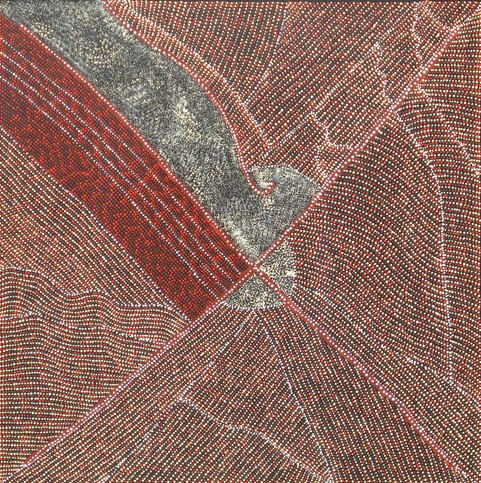ARTIST: Kathleen Petyarre c.1940 – 2018
TITLE: Mountain Devil Lizard
LANGUAGE/REGION: Anmatyerre, Alyawerre/Utopia – NT
YEAR: 2011 | 2011
DIMENSIONS: 90.0cm x 90.0cm | 106.0cm x 106.0cm
MEDIUM: synthetic polymer paints on Belgian linen
DTA CATALOGUE: #2914 | #2919
DREAMINGS: Womens Hunting, Emu, Dingo, Bush Seeds (Ntang), Mountain Devil Lizard Dreaming
Kathleen Petyarre was born circa 1940, in an important water soakage for Aboriginal people on the western boundary of Utopia Station called Atnangkere. This place is approximately 240 kilometres north-east of Alice Springs in the Northern Territory of Australia.
Kathleen Petyarre was born circa 1940, in an important water soakage for Aboriginal people on the western boundary of Utopia Station called Atnangkere. This place is approximately 240 kilometres north-east of Alice Springs in the Northern Territory of Australia.
Kathleen belongs to the Alyawarre / Eastern Anmatyerre clan and speaks Eastern Anmatyerre with English as her second language.
Kathleen has seven sisters and with their mother, they have held on to their land near Utopia Station and have now established a camp at Atneftyeye Boundary Bore. Kathleen was one of the key Anmatyerre women involved in the successful claim for the freehold title, which led to the 1979 formal hand-over of the Utopia pastoral lease back to its traditional owners.
Kathleens paintings shows her affinity with her country, culture and land especially that around Utopia with “Dreamings” that hve been inherited from her father and mother. These are: Mountain Devil Lizard, or Thorny Devil Lizard (Arnkerrthe), Women Hunting Emu, and Dingo (Atnangkerre).
Kathleen continues to demonstrate her ability to create paintings that depicts the earthiness of her land and through her art, she gives her viewers a detailed and accurate point of view of her knowledge and respect of her country. She is a highly collected artist and her works are seeked by private collectors the world over.
‘Mountain Devil Lizard’
The Mountain Devil Lizard, also known as Thorny Devil or Thorny Dragon and its latin name which is Moloch horridus.
The mountain devil lizard only grows to a maximum of about 20 centimetres and disguises itself with a look that is harsh, spiky and threatening but when touched the mountain devil lizards skin is soft and harmless. The scary exterior is natures’ way of repelling potential predators away from this nontoxic creature. The mountain devil lizard has the ability to change its skin colour to camouflage against the shades of the desert sands, land and bushes in hues of browns, tans and olive. This enhances the reptiles’ chances of survival in the harsh desert conditions. It eats very small ants and is very shy and timid. The mountain devil lizard moves slowly with a jerky motion leaving a distinguishing pattern of hemispherical tracks.
‘Arnkerrth’ (The Old Woman Mountain Devil) Dreaming
Kathleen along with her sisters and brothers has custodial rights to the Arnkerrth (The Old Woman Mountain Devil) Dreaming. This Dreaming explains the important landforms and seasonal availability of food and water on Atnangker, Gloria’s birthplace.
The story is about an Old Woman Arnkerrth who danced alone and the younger generations leaves her all alone in the desert by herself, dancing on her own. When she saw that both the young males and young females of the group had abandoned her against her wishes, she was very irritated. She was irritated not because she was left alone; she was irritated because she was the only one who had the greatest knowledge of the land and its terrain. She was the one that could lead them to food and water. The survival of all depended on her, the Old Woman Arnkerrth but the young ones did not understand this. Old Woman Arnkerrth was determined to find them and explain to them that survival in the desert is determined by the reliability of all members of the group.
Until today, there is a continuing need for formal ceremonies where dependability is ingrained into the young males and females of the group. This is to teach each of them the magnitude of being reliable and dependable at all times for the group, that each person in the group is equally as important for survival. In ceremonies, the Arnkerrth is celebrated in their Awelye (Women’s Body Paint). Paint is applied strategically on the women’s bodies and the story of Old Woman Arnkerrth is re-enacted. This enables the past, the present and the future to have a deep connection with the Dreaming, the Atnangker country and of course their ancestor Arnkerrth.
Read more about Indigenous Culture and Community
© Dreamtime Art 2019
Please Note: This biography and Intellectual Property including Indigenous Cultural Intellectual Property belongs to Dreamtime Art, the artists/their estates and is subject to copyright. To protect these copyrights, no reproduction of any or all parts is allowed unless there is prior written permission and approval by Dreamtime Art.


